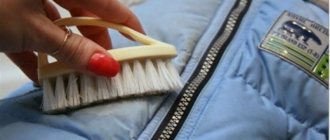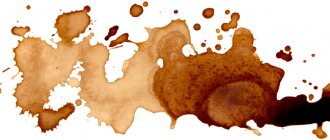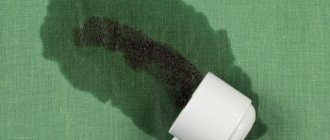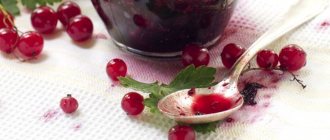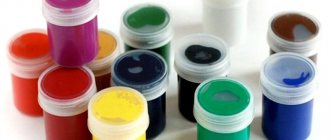Beetroot is a root vegetable that serves as an addition to salads and the main ingredient in Ukrainian borscht; it is famous for its beneficial properties and unique taste. Lovers of beets, who consume them as freshly squeezed juice or prepare many dishes, often face the problem of difficult to remove stains on clothes. It is possible to wash beets using improvised and special means.
Have you encountered this problem?
Not really
Basic cleaning rules
If you use the same methods to clean stains from a red cotton shirt and a white polyester T-shirt, you may not only waste time, but also lose your favorite item.
Washing rules:
- Synthetics should not be washed with hot water unless the manufacturer instructs to do so.
- Difficult stains need to be cleaned in several stages.
- Linen items need to be washed more thoroughly than synthetics. This process will require more effort.
- Don't put off until later what you can do now.
What not to do
The Internet is full of all kinds of advice on using bleach to remove vegetable oils from clothes. This is true, only partly. Its function does not include the dissolution or decomposition of fat. The oxygen or chlorine contained in bleaches is designed to oxidize certain substances and convert them into a soluble or colorless state. Fat is not one of these substances. Vegetable oil, on the contrary, when oxidized with oxygen, acquires the property of hardening after drying. As a result, instead of an easily removed oil stain, you can end up with a persistent stain that will remain until the end of the product’s service life.
The same applies to removing oil using hot water. In many cases, this method will cause the oil to spread over a large area and become simply a little lighter than it was to begin with.
Be careful when using plumbing cleaners. In most cases, they contain caustic, which can effectively decompose fat, but some fabrics can also easily become unusable
If there is no other way out, then you should first test the effect of the product on a small piece that will be invisible and the loss of which will not lead to irreparable consequences.
How to remove beet stains
It is difficult to wash and remove beets from clothes, but by doing everything correctly and “hot on your heels,” you can remove the stain. There are a number of options for how to remove fresh or old beet stains.
Variations for quick cleaning of fresh stains
- Boiling water. A fresh beet stain can be soaked in boiling water, and if possible, stretch the fabric under high-temperature running water. If we are talking about natural wool or cotton, then the material may suffer: deform. But since the thing is damaged in any case, it’s worth trying to remove the ugly stains. And there are also methods for restoring the shape of clothes.
- Salt. The second most popular cleansing method is table salt, which is used for both wine and blood stains. Salt should be poured onto the problem area and rubbed in gently. If the result is insufficient, you can repeat the procedure several times. After experimenting with salt, you can wash the item with laundry soap.
- Products with acid. Clothes cleaning products that contain acid have proven themselves to be excellent. This is lemon juice (natural or in the form of citric acid in bags), vinegar, whey. Whey and lemon juice are used in their pure form, soaking the contaminated area in it for a long time. Acetic acid must be diluted in a 1:1 ratio in water and poured onto the dirty stain for effect.
- Lemon acid. Citric acid in combination with ethyl alcohol acquires powerful whitening properties. You need to take about 4-5 g of acid, dilute it in water and add 30-50 ml of ethyl alcohol. The peculiarity of this method of cleansing is that it is better to boil the item in this solution. An alternative to serum can be cleaning dirt from clothes with milk, but here competent housewives have differing opinions about the effectiveness of the product. However, the method is quite well known and has been used since time immemorial, when bleaching agents were in great short supply.
Cushioned furniture
Ammonia dissolved in water will help wash both the shirt and the sofa. For 125 ml of water you will need 1 tbsp. l. ammonia. The sofa upholstery is first blotted with a paper napkin or bread crumb so that the stain does not spread. Then soak in the cleaning solution and leave for a couple of minutes. There is no need to rinse off the composition. It is simply blotted with a dry soft cloth or napkins. If necessary, repeat the procedure.
If it was not possible to completely remove the beet stain, alternatively use a foamed carpet cleaner or car chemicals for cleaning the interior. The product is first tested on an inconspicuous area of the upholstery.
Dear readers of the Tkan.Club website, if you still have questions on this topic, we will be happy to answer them. Leave your reviews, comments, share stories if you have dealt with red beet stains! Your life experience may be useful to other readers.
Old stains caused by beet juice
Of course, you will have to tinker with old stains, and perhaps this will not even bring results, but experienced housewives know and successfully apply original cleansing recipes.
- Stain remover. The most modern way to remove dried dirt is to use a store-bought stain remover. As practice shows, despite the recommendations of manufacturers who require you to simply pour the product into the washing machine, it is still better to soak the item. Chlorine bleaches are only suitable for white fabric; For non-ferrous materials it is better to use oxygen-containing products, such as Vanish.
- Baby powder. Children's powder, which contains laundry soap and special additives that enhance the effect of the detergent, is very effective. And children's clothes belong to the category of materials that are difficult to wash, as they are made from natural raw materials. The range of detergents also includes highly effective soaps with a whitening effect. If you are not afraid to lighten the fabric, then just soap the stain and wait.
- Ammonia and hydrogen peroxide. Using ammonia and hydrogen peroxide, you can remove dirt from light-colored fabrics. A few drops of ammonia are added to a glass of water, then the resulting solution is methodically rubbed into the beet stain. Things are usually boiled with hydrogen peroxide, and it is better to gently rub delicate light-colored fabrics with a tampon or sponge.
- Soda and vinegar. Kitchen towels with beetroot and other old stains can be cleaned in a strong solution of soda and vinegar. To do this, heat the water, add 2-3 tablespoons of soda and 1 tablespoon of ordinary vinegar. Dip kitchen towels into the solution and boil for a while, stirring occasionally.
- Glycerin and yolk. There is a well-known non-standard method for delicately cleaning clothes - removing dirt using glycerin and egg yolk. The mixture is made up of equal parts, applied to the material, rubbed in carefully, then washed off with warm water.
All things after gentle and not very cleansing methods are subject to subsequent washing, which will reveal the extent of the housewife’s efforts in the fight against beet juice: whether the contamination was removed.
It is also necessary to remember that the effect directly depends on the quality of the fabric. Synthetic materials have long prevailed in production, and polyester fibers are quite amenable to good powders. And natural fabrics - wool, linen, cotton - are somewhat more difficult to clean.
Methods for removing grass from clothes
The most difficult stains include grass stains that remain on clothes while walking or working in the garden. This problem is especially often encountered by mothers of children who love active games in nature. Washing colored children's clothes is a little more difficult than plain items, since there is always a risk of removing the colorful color of your favorite item along with the stain.
The main rules that will help you cope with the problem:
- Timely detection of the stain. Fresh traces of grass are easier to remove than old ones, so it’s worth inspecting things for contamination every time after a walk;
- Using a safe product. Before using one or another method of removing grass stains, it is necessary to conduct a test on an inconspicuous area of the item;
- Do not rub or soak. With physical impact, the pigment penetrates even deeper into the tissue. And simple soaking does not bring results, and can only aggravate the situation, especially if you immerse clothes in hot water;
- Do not rush. Don't expect the old stain to be quickly removed from the fabric. Even fresh stains will have to be removed for at least 4 hours. If at the moment of discovering a fresh trace of grass there is no time to remove it, then ordinary potatoes will help prevent the pigment from eating into the structure of the fabric. You just need to rub the stained area with half a raw potato;
- Getting rid of pollen. The washing process can be complicated by the presence of pollen on the grass stain. You cannot rub it, so it is recommended to clean it with tape. To do this, you need to glue a strip of regular or paper tape to the stained area and remove it along with the pollen.
Many housewives prefer to use exclusively chemical agents to remove any dirt. The advantages of this method include:
- efficiency - many stain removers quickly remove traces of vegetation;
- accessibility – you can buy a cleanser at your nearest store;
- ease of use - you just need to follow the recommendations on the packaging.
The disadvantages of chemicals include:
- high cost;
- ineffective for old pollution;
- risk of damage to clothing if instructions are not followed.
There are also adherents of traditional stain removal methods. The advantages of these include the following:
- accessibility - most of the necessary components are always at hand;
- efficiency - some products can cope even with old stains;
- cheapness;
- safety.
The disadvantages of traditional methods of dealing with traces of grass on clothes include only the long process of removing stains. To remove stains, you will have to be patient and, as a rule, be prepared to repeatedly process the clothing.
Review of popular folk remedies for beet juice
Boiled, fresh beets are considered a source of persistent traces. When faced with the problem of a beet stain, do not panic, get upset, or even throw the item away. It is possible to get rid of traces at home. Proven methods and techniques can remove root stains. Among the popular folk remedies to remove stains from beet juice are common products: alcohol, salt, milk, laundry soap, vinegar, citric acid.
- How to remove coffee stains quickly and effectively
- Review of special products for washing coffee stains
- Foundation stain: how to clean clothes
Laundry soap
A budget option for eliminating beet juice is 72% laundry soap purchased at the nearest store. New traces are washed off better. Wet the stained area, lather thoroughly, and leave for 10 minutes. Wash and rinse with water at room temperature. If necessary, repeat the process.
Vinegar and citric acid
You can destroy fresh dirt and save stained light-colored fabric using a vinegar-water solution, keeping the proportions 1:1. Generously wet clothing with liquid and leave for 6-12 minutes. Wash with laundry soap or washing powder (allowed with bleaching ingredients).
Citric acid in bags or natural fresh lemon juice are equally suitable. The acid should be applied to the stained area and left for 8-10 minutes. Afterwards, remove from fabric and wash as normal. For delicate fabric, make a solution of warm water with the addition of citric acid.
Prolonged use of lemon juice or acid on clothing is dangerous due to corrosion of the material. This method is not recommended for silk, but is suitable for linen and cotton.
Salt and milk
A widely used technique for cleaning a trail is salt. If you spill juice on a T-shirt while visiting, at work or another place, there is no way to immediately wash the clothes. Sprinkle salt on the stain. A similar result will be obtained from diluted salt in water, rubbing the mixture in a circular motion on the problem area.
Milk will remove the mark without damaging the fabric fibers. Wet your clothes with cold water and pour a cup of hot milk, leave for several hours. Rinse in cool water and wash. The fresher the milk, the more effectively it removes impurities.
- How to remove coffee stains from clothes
- How to remove tea stains: black, green
- What not to do when removing coffee stains from clothes
If milk is not available, use whey. Soak the affected area of fabric with milk or whey for 30-60 minutes, rinse the item. To consolidate the result, it is recommended to wash the clothes by hand or in a washing machine with the addition of powder.
Alcohol
You can use ethyl or ammonia.
| Ammonia | Ethanol |
| Allows you to remove stains in 5 minutes. It is necessary to mix ammonia and water in equal proportions, soak a cotton pad in the solution, and thoroughly wipe the stain with it until it completely disappears. |
|
It is important to remember: do not delay washing. This will minimize the cost of time and effort.
Cotton and linen
How to remove beet stains from cotton and linen clothes? It is recommended to wash linen items in hot water and soda. You can remove old beet stains with both hydrogen peroxide and a 5% ammonia solution. You can remove stains with sodium hydrogen sulfate and peroxide. First, the mark is sprinkled with sodium bisulfate, then hydrogen peroxide is dripped in, and then washed off with cool water. If you acidify it with vinegar or citric acid, the effect will be better.
Special chemicals
An alternative to removing stains with folk remedies is to remove stains using special chemicals. There are a lot of chemicals that will help remove beet stains. A significant part of them have an effect without destroying the fibrous structure of the fabric. It is important to read the manual that comes with the product and follow the recommendations.
| Chemical agent | Rules of application |
| Hydrogen peroxide | Before removing a stain from a white T-shirt, we use concentrated hydrogen peroxide, apply it to the stain and wash it. |
| Ammonia | Place thick paper under the product so that the dye imprints on it. Dilute alcohol with water in a ratio of 10:0.5, treat the contaminated area with a washcloth. We wash clothes with powder. |
| Stain remover (Vanish, ACE, etc.) | There are many types of stain removers; it is important to choose the product for the desired fabric. Dilute 1 tbsp. stain remover in cold water, lower the item and soak for a couple of hours. Turn on the washing machine to normal mode and start the wash. To achieve a better result, add a little more powder during washing. |
| Dishwashing detergents (Fairy, Sorti, Eared Nannies, etc.) | Apply a drop of liquid gel to the stain, wait for it to dry completely, wash the item as usual, then rinse thoroughly in water. |
| Oxygen bleach | Dilute the powder with water in the required proportions indicated on the package. Apply the mixture to the stained area and wait the required time. Wash your clothes in the washing machine. |
I want o. It contains chlorine and should be used with caution. The chemical composition of the stain remover prohibits its use for colored, delicate items. Before applying to fabric, dilute it with water, apply to an inconspicuous area of the material and check the reaction of the fabric to the substance.
Before using any chemical, carefully read the manufacturer's recommendations!
Modern methods and techniques help remove stains from carpets, jeans and other dense fabrics and thin materials. Using the recommendations, you will quickly and efficiently get rid of beet traces!
Delicate fabrics
How to remove stains from delicate fabric? For a silk blouse or shirt, the following recipe is suitable: soak the item in milk for half an hour. Rinse with cool water and wash with powder or liquid detergent. Whey can replace milk.
How to wash beets on woolen clothes? For this, ammonia is useful, which is diluted with water and applied to the stain. Afterwards, the item is rinsed, and the remaining print is treated with shampoo or dishwashing gel. Upon completion, the item is washed with a suitable product.
Reminders
It is important that we are concerned not only with how to remove a grease stain from clothes, but also not to choose too aggressive means to ensure that the items remain intact. And here's some more useful information
REMINDER
- It is advisable to have something that can be used to remove oil stains from clothes, that is, a suitable tool: cotton swabs, napkins, brushes, cotton rags.
First, use a weaker solution to see how it can remove an oil stain. If possible, use a more concentrated solution.
Contamination is removed from both the front and back sides.
Of course, where we put the grease stain on ourselves plays a role. We will build on this: what we have at hand. If we neutralize a greasy stain from clothes at home or at a party, then almost everything is used, from chemicals to scissors, which will help radically combat the problem by cutting fashionable holes on the clothes. Or, at least, sewing a nice badge in place of the “award”.
And this is also an option when it seems that we have done everything, but our successes have not been crowned with success.
*when copying material, please be sure to indicate an active link to the source https://mirpozitiva.ru/
We use household chemicals
If you have doubts about the effectiveness of home methods or if your attempt to remove a beet stain is unsuccessful, it is better to use special products.
Good results show:
- Frau Schmidt, specially designed to remove vegetable stains and grease from any fabric;
- Amway, an effective but expensive remedy;
- Vanish, used to remove complex stains from colored fabrics;
- Antipyatin in the form of soap or powder.
It is necessary to use household chemicals strictly following the manufacturer's recommendations (located on the packaging). Failure to follow the instructions for use or exceeding the dosage can damage the fabric.


